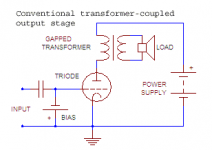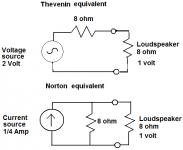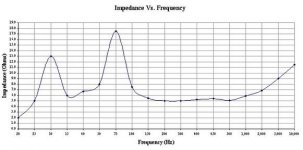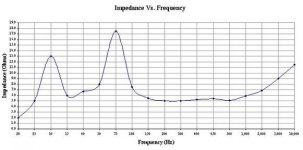I have some Klipsch Heresy II's with the round cup back where the binding posts are. A few years back I got some Sonicaps from Bob Crites and did the crossovers myself. I have had them hooked up to my Scott 299A mainly and have been using the 8 ohm tap regardless of the speakers saying nominal impedance 4 ohms. The amp sounds better to me with the 8 ohm taps rather than the 4. A friend was over and told me I was damaging my amp using it this way lol........anyway I know I am not damaging the amp but after some digging I haven't gotten a definitive answer. I have read two answers, one is that the woofer at lower frequencies is 4 ohms, and the other is that it was a marketing scheme at the time to boost sales to solid state amp users hoping to get more power from the 4 ohm load.
Maybe somebody can shine some light on this for me.
-Thanks
Maybe somebody can shine some light on this for me.
-Thanks
Try measuring the frequency response from either tap at a decently high SPL. The "right tap" will depend on the speakers' impedance profile, which is not by any means resistive.
My guess is that the 4-ohm tap, which should have the lowest output impedance, is going to be the most accurate while the 8-ohm tap is probably measurably colouring the sound.
My guess is that the 4-ohm tap, which should have the lowest output impedance, is going to be the most accurate while the 8-ohm tap is probably measurably colouring the sound.
Last edited:
The only reason that your amplifier is still alive is because your speakers are incapable to produce true bass sound.
There is no true woofer drive in them.
Please explain. Are you speaking in terms of high power levels? When you say "There is no true woofer drive in them" are you talking about the frequency response of the speakers or the amp? If you are talking about the speakers being rated down to 63Hz and not 20Hz are you saying if they did reach lower my amp would blow up?
Your response is very vague, and you have not presented any data to support your claim. Also your response does not remotely answer my original question. I am sure your systems bass is "superior".
I do have a subwoofer for supplemental bass when using with this system FWIW.
Try measuring the frequency response from either tap at a decently high SPL. The "right tap" will depend on the speakers' impedance profile, which is not by any means resistive.
Thanks I will give this a try. I am guessing the tap with the highest transfer at the lowest frequency is what I am looking for?
Let's ask the right question! We know that valve amplifiers, which are current sources, dislike driving an open circuit, because they push more and more volts at the load to try and get some current flowing. Transistor amps, which are voltage sources dislike short circuit, because they push more and more amps at the load. These conditions will cause damage to the amps' output stage potentially.
Therefore if I am using the 8 ohm tap of a valve amplifier into a 4 ohm load, is this safe for the amplifier?
I think so. For a valve amp you are pushing it nearer to a short circuit load condition, which it won't mind. It won't be the most EFFICIENT setting, however and it won't go as loud overall.
Tonally, the sound will change with a significant amplifier output impedance. Feedback complicates this, but in general, output from the speaker will increase as the speaker impedance goes higher. Hence the effort to keep speaker impedance flat when designing a valve-friendly speaker. If the impedance is flat, the tone won't change with any sort of amplifier output impedance variation.
Hope I got that right!
Therefore if I am using the 8 ohm tap of a valve amplifier into a 4 ohm load, is this safe for the amplifier?
I think so. For a valve amp you are pushing it nearer to a short circuit load condition, which it won't mind. It won't be the most EFFICIENT setting, however and it won't go as loud overall.
Tonally, the sound will change with a significant amplifier output impedance. Feedback complicates this, but in general, output from the speaker will increase as the speaker impedance goes higher. Hence the effort to keep speaker impedance flat when designing a valve-friendly speaker. If the impedance is flat, the tone won't change with any sort of amplifier output impedance variation.
Hope I got that right!
Attachments
Let's ask the right question! We know that valve amplifiers ......
Wait a minute ...
I just realized that this topic is about an valve amplifier, and my first thought is to start running away as faster I can from it.
An valve amplifier is a different animal compared to transistors, and in this case instead of getting personally in a technical analysis, I would suggest a better reading of the Users manual or an email to be send to the manufacturer, only he is aware of the true potentials of this equipment.
Let's ask the right question! We know that valve amplifiers, which are current sources, dislike driving an open circuit, because they push more and more volts at the load to try and get some current flowing. Transistor amps, which are voltage sources dislike short circuit, because they push more and more amps at the load. These conditions will cause damage to the amps' output stage potentially.
Therefore if I am using the 8 ohm tap of a valve amplifier into a 4 ohm load, is this safe for the amplifier?
I think so. For a valve amp you are pushing it nearer to a short circuit load condition, which it won't mind. It won't be the most EFFICIENT setting, however and it won't go as loud overall.
Tonally, the sound will change with a significant amplifier output impedance. Feedback complicates this, but in general, output from the speaker will increase as the speaker impedance goes higher. Hence the effort to keep speaker impedance flat when designing a valve-friendly speaker. If the impedance is flat, the tone won't change with any sort of amplifier output impedance variation.
Hope I got that right!
Great answer! And yes you did get it right. I do understand the theory, which would tell me the transfer would be less when using a 4 ohm load on the 8 ohm tap. But this isn't the case with these speakers, hence my question, I do NOT think the speakers in fact are a 4 ohm load but actually an 8 ohm load, which is why I think it was a marketing scheme to write on the back nominal impedance 4 ohms.
Anyway valve amps usually can take 100% mismatch in loads without doing damage.........but you will get performance differences. In my case I do not believe I am mismatching the load for the speakers are actually 8 ohms instead of the marked 4 ohms.
I guess I can try and contact Klipsch about this but my suspicions are that the speakers are in fact 8 ohms for I get the best transfer with the 8 ohm tap.
Only effects-box designs. When engineered, they're generally closer to a voltage source. 0.5 ohm is not unreasonable, and 1 ohm is a reasonable max. It *will* change the frequency response into a load with a varying impedance (99% of speakers), the question is how much and is it beneficial or a degradation for a particular speaker/amp combination. Very different than a current source which has a source impedance >> load impedance....which are current sources
Only effects-box designs. When engineered, they're generally closer to a voltage source. 0.5 ohm is not unreasonable, and 1 ohm is a reasonable max. It *will* change the frequency response into a load with a varying impedance (99% of speakers), the question is how much and is it beneficial or a degradation for a particular speaker/amp combination. Very different than a current source which has a source impedance >> load impedance.
This is true, an ideal current source has an infinite source resistance and a ideal voltage source has zero source impedance. My amp does use a good amount of feedback, although I do not know the output impedance I am willing to bet it is less than 1.
If my speakers were 4 ohms I would expect less voltage out using the 8 ohm tap, but they measured similar to what I read on the bench using a 8 ohm dummy load. I guess I could use two of my 8 ohm dummy loads in parallel to test my hypothesis, maybe there won't be a difference.
As far as frequency response I have not done any testing yet using different taps, but like I said it sounds best with the 8 ohm tap.
I think I mentioned that voltage feedback complicates a simple analysis, but nevertheless the broad picture is true. It always surprised me that the way to damage a valve amplifier was to run it with no load! 
You'd have to measure the DC resistance of the drivers with a multimeter and factor in the filter and bass loading to guess the actual impedance.
You'd have to measure the DC resistance of the drivers with a multimeter and factor in the filter and bass loading to guess the actual impedance.
@famous
You're designing for an audience of one. If that's the choice you like best, declare victory, stop screwing around, and go listen to music!
In the product development world, we have a saying that at some point in a project, it's time to shoot the engineer and start getting it out the door. The great philosopher Jerry Seinfeld told George Costanza that when he gets off a line that invokes laughter, just shut up and smile, say, "Thanks!" and back out the door.
You're designing for an audience of one. If that's the choice you like best, declare victory, stop screwing around, and go listen to music!
In the product development world, we have a saying that at some point in a project, it's time to shoot the engineer and start getting it out the door. The great philosopher Jerry Seinfeld told George Costanza that when he gets off a line that invokes laughter, just shut up and smile, say, "Thanks!" and back out the door.
@famous
You're designing for an audience of one. If that's the choice you like best, declare victory, stop screwing around, and go listen to music!
In the product development world, we have a saying that at some point in a project, it's time to shoot the engineer and start getting it out the door. The great philosopher Jerry Seinfeld told George Costanza that when he gets off a line that invokes laughter, just shut up and smile, say, "Thanks!" and back out the door.
lol I am really bored
...valve amplifiers, which are current sources... ...Transistor amps, which are voltage sources...
A gross simplification, but one which encourages a kind of 'in the limit' thinking which is frequently instructive. Doesn't require justification, or really merit objection.
We know that valve amplifiers, which are current sources....Transistor amps, which are voltage sources dislike short circuit, because they push more and more amps at the load.
That 1st part is not true. Many tube amplifiers, particularily SE, have highish output impedance, but VERY few have one that is greater than the impedance of the speaker which would be needed to put them on the side of the divider that would make them"current" amps.
dave
That 1st part is not true. Many tube amplifiers, particularily SE, have highish output impedance, but VERY few have one that is greater than the impedance of the speaker which would be needed to put them on the side of the divider that would make them"current" amps.We know that valve amplifiers, which are current sources....Transistor amps, which are voltage sources dislike short circuit, because they push more and more amps at the load.
dave
Shameful misquoting there, Dave!
Let's ask the right question! We know that valve amplifiers, which are current sources, dislike driving an open circuit, because they push more and more volts at the load to try and get some current flowing. Transistor amps, which are voltage sources dislike short circuit, because they push more and more amps at the load. These conditions will cause damage to the amps' output stage potentially.
Therefore if I am using the 8 ohm tap of a valve amplifier into a 4 ohm load, is this safe for the amplifier?
I think so. For a valve amp you are pushing it nearer to a short circuit load condition, which it won't mind. It won't be the most EFFICIENT setting, however and it won't go as loud overall.
Tonally, the sound will change with a significant amplifier output impedance. Feedback complicates this, but in general, output from the speaker will increase as the speaker impedance goes higher. Hence the effort to keep speaker impedance flat when designing a valve-friendly speaker. If the impedance is flat, the tone won't change with any sort of amplifier output impedance variation.
Hope I got that right!
You really been hanging round that s***** guy too much!
I'd happily concede that most valve amps are actually current source with voltage feedback though.
Back on topic, IMO the 8 ohm tap will produce woollier bass and a brighter top end than the 4 ohm tap if the below impedance curve is right. A slight effect.
Attachments
Shameful misquoting there, Dave!
Huh? The words are all yours.
A true current amp has infinite output imedance (or close enuff)
A true voltage amp has zero output imedance (or close enuff)
The dividing line is output impedance = speaker impedance.
I'd happily concede that most valve amps are actually current source with voltage feedback though
Ir makes no difference how an amp gets its output impedance.
A SET with no feedback is, AFAIS, still on the voltage side of the divider.
A pentode amp with no feedback can be on the current amp side, you will find few of those, but with an appropriate speaker can work very well (amp/speaker/connection are a system that cannot be completely evaluated apart)
dave
100% true except you WERE selectively quoting me to create an impression I was not allowing for feedback, which reduces output impedance. But why are we arguing?Huh? The words are all yours.
A true current amp has infinite output imedance (or close enuff)
A true voltage amp has zero output imedance (or close enuff)
The dividing line is output impedance = speaker impedance.
Ir makes no difference how an amp gets its output impedance.
A SET with no feedback is, AFAIS, still on the voltage side of the divider.
A pentode amp with no feedback can be on the current amp side, you will find few of those, but with an appropriate speaker can work very well (amp/speaker/connection are a system that cannot be completely evaluated apart)
dave
Since the topic is just about dealt with, we could discuss the related Maximum power transfer theorem. That is an interesting piece of pure theory that applies to ANY amplifier or filter. I like that sort of stuff.
- Status
- This old topic is closed. If you want to reopen this topic, contact a moderator using the "Report Post" button.
- Home
- Loudspeakers
- Multi-Way
- Impedance marketing?




 posts deleted, please shoot the message and not the messenger....
posts deleted, please shoot the message and not the messenger....